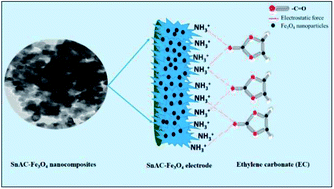Preparation of Sn-aminoclay (SnAC)-templated Fe3O4 nanoparticles as an anode material for lithium-ion batteries†
Abstract
Sn-aminoclay (SnAC)-templated Fe3O4 nanocomposites (SnAC–Fe3O4) were prepared through a facile approach. The morphology and macro-architecture of the fabricated SnAC–Fe3O4 nanocomposites were characterized by different techniques. A constructed meso/macro-porous structure arising from the homogeneous dispersion of Fe3O4 NPs on the SnAC surface owing to inherent NH3+ functional groups provides new conductive channels for high-efficiency electron transport and ion diffusion. After annealing under argon (Ar) gas, most of SnAC layered structure can be converted to SnO2; this carbonization allows for formation of a protective shell preventing direct interaction of the inner SnO2 and Fe3O4 NPs with the electrolyte. Additionally, the post-annealing formation of Fe–O–C and Sn–O–C bonds enhances the connection of Fe3O4 NPs and SnAC, resulting in improved electrical conductivity, specific capacities, capacity retention, and long-term stability of the nanocomposites. Resultantly, electrochemical measurement exhibits high initial discharge/charge capacities of 980 mA h g−1 and 830 mA h g−1 at 100 mA g−1 in the first cycle and maintains 710 mA h g−1 after 100 cycles, which corresponds to a capacity retention of ∼89%. The cycling performance at 100 mA g−1 is remarkably improved when compared with control SnAC. These outstanding results represent a new direction for development of anode materials without any binder or additive.



 Please wait while we load your content...
Please wait while we load your content...